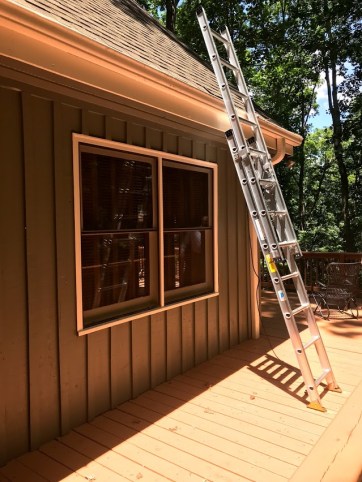There are many types of ladders, and choosing the proper one for the job is the first step in ensuring ladder safety. The single ladder is a non-self-supporting portable ladder with a set length ranging up to 30 feet. The extension ladder is similar to the single ladder; however, its two or more sections that travel in guides or brackets allow its length to adjust and for users to reach greater heights.
Here are some quick tips on how to properly choose between and use single and extension ladders. For more information on the proper use of both single and extension ladders, visit American Ladder Institute’s Ladder Safety Training Library.
The Difference Between Single and Extension Ladders
Single and extension ladders are similar and therefore share the same safety tips. The main difference between the two is that an extension ladder is adjustable, allowing you to reach various heights depending on the job’s needs. Extension ladders are preferred for exterior projects, such as cleaning gutters or painting shutters, as they are available in taller sizes than stepladders. Larger models have a pulley and rope to help raise the fly section. Single ladders are not adjustable, have a single section, and are best utilized for projects that don’t require lengthened height, such as painting indoors or washing windows.
Single and Extension Ladder Safety
Single and extension ladders share many common safety tips:
- Both single and extensions ladders require level ground for two support points in addition to a top support (e.g. wall, tree, house, etc.). The top two side rails should be equally supported, unless the ladder is equipped with a single-support attachment for specific situations such as pole light standard or building corners.
- If the extension ladder comes equipped with a rope and pulley, use that to extend the ladder to the desired height.
- To avoid the ladder from sliding out and the balance of the climber, single and extension ladders should be erected at a pitch of 75 1/2° from the horizontal. A simple rule for setting up the ladder at the correct angle is to place the base at a distance from the wall/upper support equal to ¼ of the length of the ladder side rails.
- Make sure the rung locks are engaged—never assume that they are.
- When climbing, always face the ladder, keep your center of gravity between the two side rails (do not overreach), and maintain three points of contact. And remember, the highest standing point on a single or extension ladder is the third rung from the top.
For more information on the safety requirements for the construction, performance, use, and care of single and extension ladders, refer to the following standards:
- ANSI A14.1 (Portable Wood Ladders)
- ANSI A14.2 (Portable Metal Ladders)
- ANSI A14.5 (Portable Reinforced Plastic Ladders)
National Ladder Safety Month
In addition to promoting safe ladder use in your home and workplace, get involved in National Ladder Safety Month—the nationwide initiative focused on increasing awareness of safe ladder use and decreasing ladder accidents—this March. Take advantage of free resources to build awareness and share with your friends or coworkers, including: ladder safety training videos, safety posters, infographics, and short videos. Join the online conversation by using #LadderSafetyMonth on your favorite social platforms.
Contributing Author: American Ladder Institute (ALI)
ALI is the American National Standards Institute (ANSI) approved developer of ladder safety Standards. Standards are technical specifications, developed and tested by subject experts, which prescribe rules governing the safety construction, design, testing, care, and use of various types of ladders.
